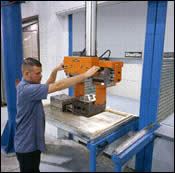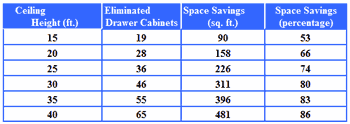Five Ways To Leaner Die Handling
Here’s some practical information to keep in mind if you’re considering adding a large-scale anodizing line to your facility.
Share





Hwacheon Machinery America, Inc.
Featured Content
View More
ECi Software Solutions, Inc.
Featured Content
View More




Conventional rack, shelving, and drawer systems used in many stamping facilities are a less-than-lean method of storing dies. They consume a lot of floor space, and locating and retrieving dies encroaches on production time. In addition, these conventional methods expose dies to damage.
The focus of lean manufacturing initiatives is to eliminate waste that occurs during manufacturing operations and to optimize process flow to improve overall efficiency. Vertical automated storage and retrieval systems address five lean manufacturing goals for stamping die storage options: maximizing space utilization, increasing employee productivity, ensuring safety, optimizing equipment efficiency, and reducing tooling costs.
How Vertical Systems Address Five Lean Goals
1. By Saving Floor Space. One of the ways a vertical storage and retrieval system helps meet lean manufacturing initiatives is by improving space utilization because they use otherwise unoccupied vertical space. Depending on the useable building interior heights, up to 85 percent of a conventional storage system’s occupied floor space can be recovered.
Recovered floor space can be re-allocated from cost-associated inventory functions to value-increasing production operations. Improved space utilization also can extend the useful life of existing facilities, eliminating the need for expensive brick and mortar expansion to meet growth requirements.
2. By Reducing Redundant Handling. Vertical systems help reduce redundant or non-essential handling, especially in applications requiring frequent reuse of stamping dies.
The small unit footprint makes vertical systems especially valuable for point-of-use storage. Storing dies and other tooling at point-of-use reduces unnecessary processing and transportation common with central storage.
3. By Reducing Tooling Costs. Die damage caused by frequent handling can interrupt process flow. Because vertical storage and retrieval systems are enclosed and lockable, they protect stored items from external hazards and reduce product damage. Likewise, vertical systems can integrate software controls that can restrict and track die usage to specific individuals, departments or shifts.
4. By Improving Safety. The access area of vertical systems is ergonomically designed to present stored items at an ideal height for picking, usually about waist high. This reduces unnecessary or excess motion and contributes to employee safety because this ergonomic positioning design eliminates the bending, climbing, and stretching associated with conventional shelving and rack systems.
5. By Increasing Equipment Uptime. Another key lean goal is reduction of wait time. Conventional static storage systems require employees to spend up to 70 percent of their time traveling aisles searching for items, while only 30 percent is spent actually retrieving items. Vertical storage and retrieval systems allow quick access to stored items via a system of rotating carrier shelves or delivered trays that bring the exact storage position to the operator. Typically, a vertical system reverses that 70 to 30 percent ratio.
The systems can be configured to store various-sized items from dies to tooling to fasteners to safety products, and can be easily reconfigured to accommodate physical changes in stored items, such as finished goods, allowing shops to keep on hand only what they need.
Vertical storage and retrieval systems can be equipped microprocessor controls, position indicators, information displays and PC-based software to further increase the speed at which specific tooling is located and retrieved in the system.
Controlling System Operation
Vertical storage and retrieval systems can be controlled using PC software or hardware controls. A system can be configured for stand-alone, single-user operation, or multi-user network use. The operator simply enters the shelf number using the controls, and the shelf and its contents are delivered automatically.
For functional effectiveness, transaction information must be communicated between the operator and the control system. The level of the system’s sophistication will help determine how the information will be displayed to the operator.
For example, in a strictly manual system, the operator decides all location transactions and enters, via keypad, the shelf or trays locations. This activity is followed by manual inventory adjustments.
In a fully automated environment, all information requests from location selection, container type, inventory adjustment, activity analysis, and data transfers between the vertical system’s software and the facility’s host system, such as a shop’s MRP system. This can be accomplished transparently with no operator intervention.
Selecting the Right System
Because they help shops meet the requirements for lean manufacturing, vertical storage and retrieval systems can have a verifiable positive return in terms of improved operating efficiency if they are properly configured for specific applications. Integrated vertical storage and retrieval systems often have a return on investment (ROI) of less than 18 months.
However, as with any major investment, a comparison of the costs of the new system versus the old system must be considered. Sitting down with an installation specialist and putting the numbers into a standard return on investment/internal rate of return (ROI / IRR) formula is one way to do this. Another way is to use a special ROI/IRR calculator that allows users to enter the appropriate data that automatically computes the daily costs of the current system and the new system. The calculator also computes dollar savings from reduced space requirements, cost savings from improved employee productivity, depreciation savings, and total annualized savings. From this information, the calculator helps determine the payback schedule for the user’s specific installation.
Is a Vertical Storage and Retrieval System Right for Your Shop?
Because vertical systems can be equipped with many variations of shelf and tray configurations, load data is used to design the application to the need. For the storage of stamping dies, weight is a primary consideration. When defining system requirements, average weight density information is calculated to determine shelf or tray loading requirements. Once load data has been determined and grouped by size and weight, it can be used to determine optimum vertical spacing, depth and width.
Consideration must also be given to the physical layout of the installation site. The clear height of the building interior will determine the height of the units and the total number of shelves or trays allowed in each unit. It is possible to estimate space savings in square feet and percentages using general formulas developed by automated storage and retrieval system manufacturers (see Figures 1 and 2).
For example, in a facility with a ceiling height of 40 feet, a vertical storage and retrieval system can eliminate up to 100 shelving sections with a resulting space savings of up to 929 square feet, or 91 percent. With a ceiling height of 30 feet, a vertical solution can eliminate 46 drawer-type cabinets for a space savings of 311 square feet, or 80 percent.
Industrial buildings with at least 4 to 6 inches of reinforced concrete over a solid, compacted base will support most loaded vertical systems.
Remstar International Inc., a company of the Kardex AG Remstar International (KRI) Group of Zurich, Switzerland, is a leading provider of automated storage and retrieval systems for manufacturing, distribution and warehousing applications. For information on lean Remstar solutions, call 800-639-5805 or visit the Remstar web site at www.Remstar.com.
Read Next
Building Out a Foundation for Student Machinists
Autodesk and Haas have teamed up to produce an introductory course for students that covers the basics of CAD, CAM and CNC while providing them with a portfolio part.
Read MoreRegistration Now Open for the Precision Machining Technology Show (PMTS) 2025
The precision machining industry’s premier event returns to Cleveland, OH, April 1-3.
Read More5 Rules of Thumb for Buying CNC Machine Tools
Use these tips to carefully plan your machine tool purchases and to avoid regretting your decision later.
Read More


















.png;maxWidth=150)












.png;maxWidth=300;quality=90)








.jpg;maxWidth=300;quality=90)







